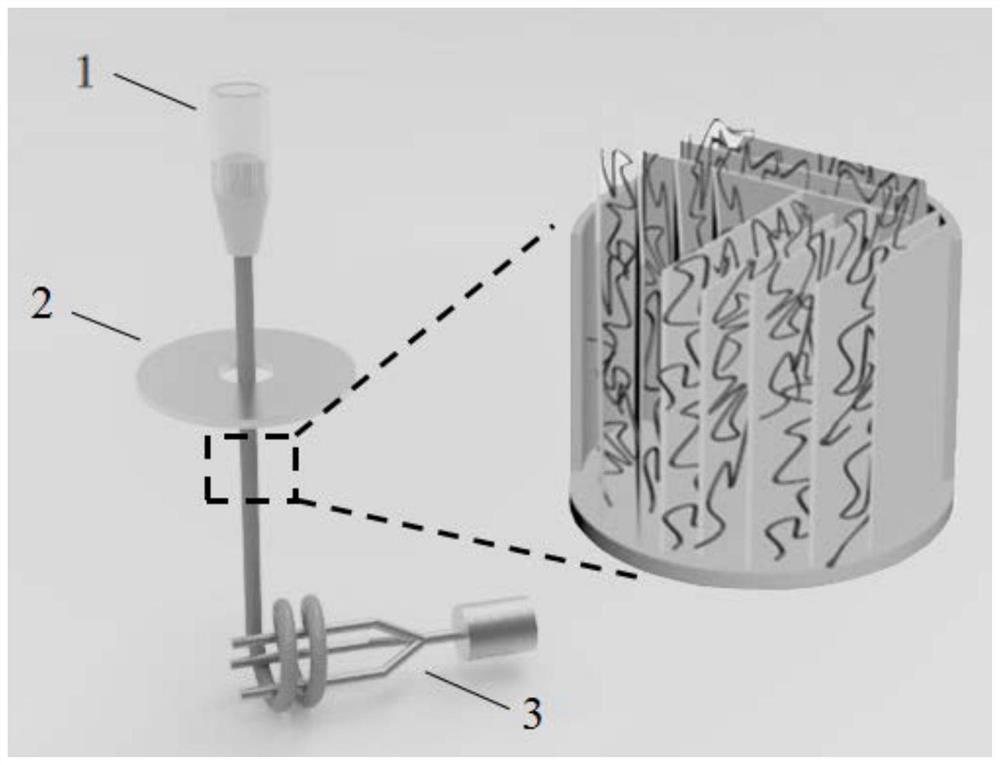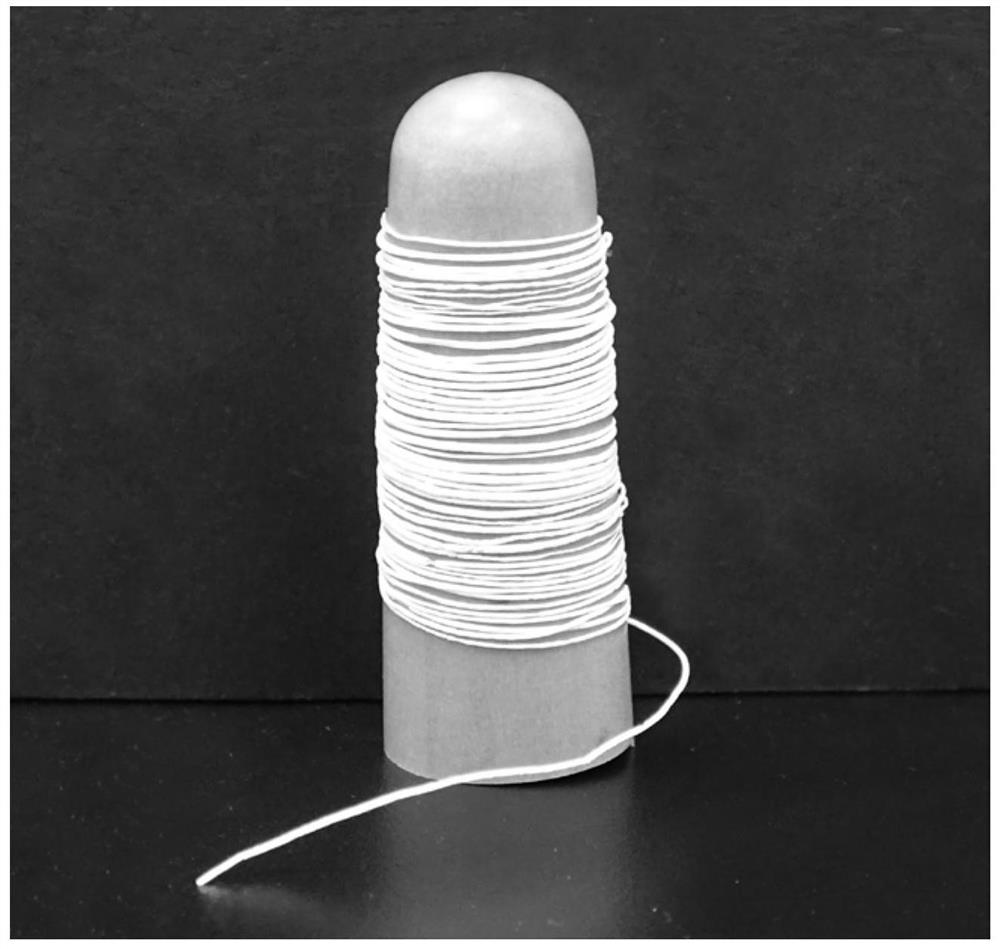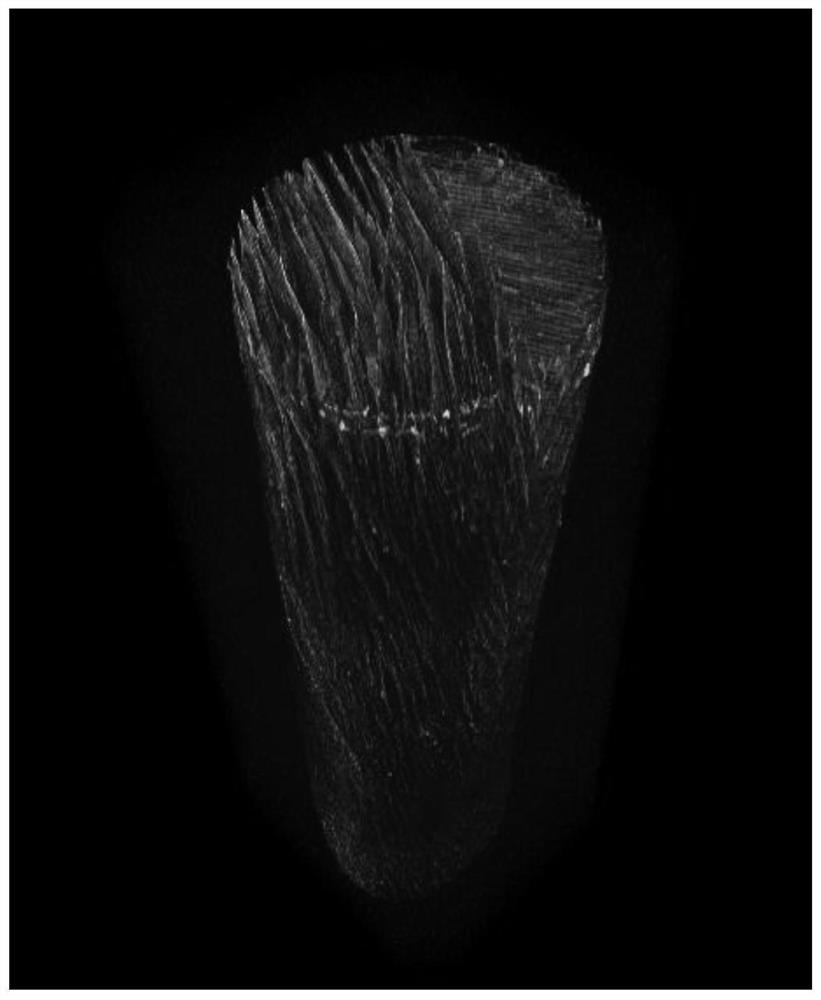Preparation method, product and application of superhydrophobic porous fiber with oriented pore structure
A porous fiber and super-hydrophobic technology, which is applied in the field of preparation of super-hydrophobic porous fibers, can solve the problems of not having super-hydrophobic properties, limiting the application of porous fibers, and being unable to realize continuous large-scale preparation.
- Summary
- Abstract
- Description
- Claims
- Application Information
AI Technical Summary
Problems solved by technology
Method used
Image
Examples
Embodiment 1
[0088] (1) Cut 4.5g of natural cocoons, boil and dry in 1% sodium carbonate solution, dissolve in 20ml of 9mol / ml lithium bromide solution, and dialyze for 24h to prepare a 22.5% silk protein solution.
[0089] Dissolve 0.5 g of chitosan powder in 10 ml of 1% acetic acid solution, stir for 30 min at a speed of 800 rpm / min to make it evenly mixed, and prepare a chitosan solution with a concentration of 50 mg / ml.
[0090] Mix 20ml of silk protein solution and 10ml of chitosan solution evenly, and centrifuge to remove air bubbles to obtain a homogeneous solution, wherein the mass ratio of silk protein to chitosan is 9:1.
[0091] (2) Put the mixed solution in the syringe, extrude the solution through the extrusion pump, place the copper ring in a low-temperature reaction bath (-100°C), and pass the solution through the copper ring for freezing-spinning process, and the frozen The fibers are collected with a motor.
[0092] (3) Freeze-dry the frozen fiber obtained in step (2) for...
Embodiment 2
[0096] (1) Cut 4.5g of natural cocoons, boil and dry in 1% sodium carbonate solution, dissolve in 20ml of 9mol / ml lithium bromide solution, and dialyze for 24h to prepare a 22.5% silk protein solution.
[0097]Dissolve 0.5 g of chitosan powder in 10 ml of 1% acetic acid solution, stir for 30 min at a speed of 800 rpm / min to make it evenly mixed, and prepare a chitosan solution with a concentration of 50 mg / ml.
[0098] After mixing 20ml of silk protein solution and 10ml of chitosan solution evenly, centrifuge to remove air bubbles to obtain a homogeneous solution, wherein the mass ratio of silk protein to chitosan is 9:1.
[0099] (2) Put the mixed solution in the syringe, extrude the solution through the extrusion pump, place the copper ring in a low temperature reaction bath (-40, -60, -80, -100°C respectively), and pass the solution through the copper ring Freezing-spinning process, and the frozen fibers are collected by motor.
Embodiment 3
[0105] (1) Cut 4.5g of natural cocoons, boil and dry in 1% sodium carbonate solution, dissolve in 20ml of 9mol / ml lithium bromide solution, and dialyze for 24h to prepare a 22.5% silk protein solution.
[0106] Dissolve 0.5 g of chitosan powder in 10 ml of 1% acetic acid solution, stir for 30 min at a speed of 800 rpm / min to make it evenly mixed, and prepare a chitosan solution with a concentration of 50 mg / ml.
[0107] After mixing 20ml of silk protein solution and 10ml of chitosan solution evenly, centrifuge to remove air bubbles to obtain a homogeneous solution, wherein the mass ratio of silk protein to chitosan is 9:1.
[0108] (2) Put the mixed solution in the syringe, extrude the solution through the extrusion pump, place the copper ring in a low-temperature reaction bath (the temperature is -100°C), pass the solution through the copper ring for freezing-spinning process, and freeze The final fiber is collected by motor.
[0109] (3) Freeze-drying the frozen fiber obtai...
PUM
| Property | Measurement | Unit |
|---|---|---|
| concentration | aaaaa | aaaaa |
| diameter | aaaaa | aaaaa |
| pore size | aaaaa | aaaaa |
Abstract
Description
Claims
Application Information
 Login to View More
Login to View More - R&D
- Intellectual Property
- Life Sciences
- Materials
- Tech Scout
- Unparalleled Data Quality
- Higher Quality Content
- 60% Fewer Hallucinations
Browse by: Latest US Patents, China's latest patents, Technical Efficacy Thesaurus, Application Domain, Technology Topic, Popular Technical Reports.
© 2025 PatSnap. All rights reserved.Legal|Privacy policy|Modern Slavery Act Transparency Statement|Sitemap|About US| Contact US: help@patsnap.com



